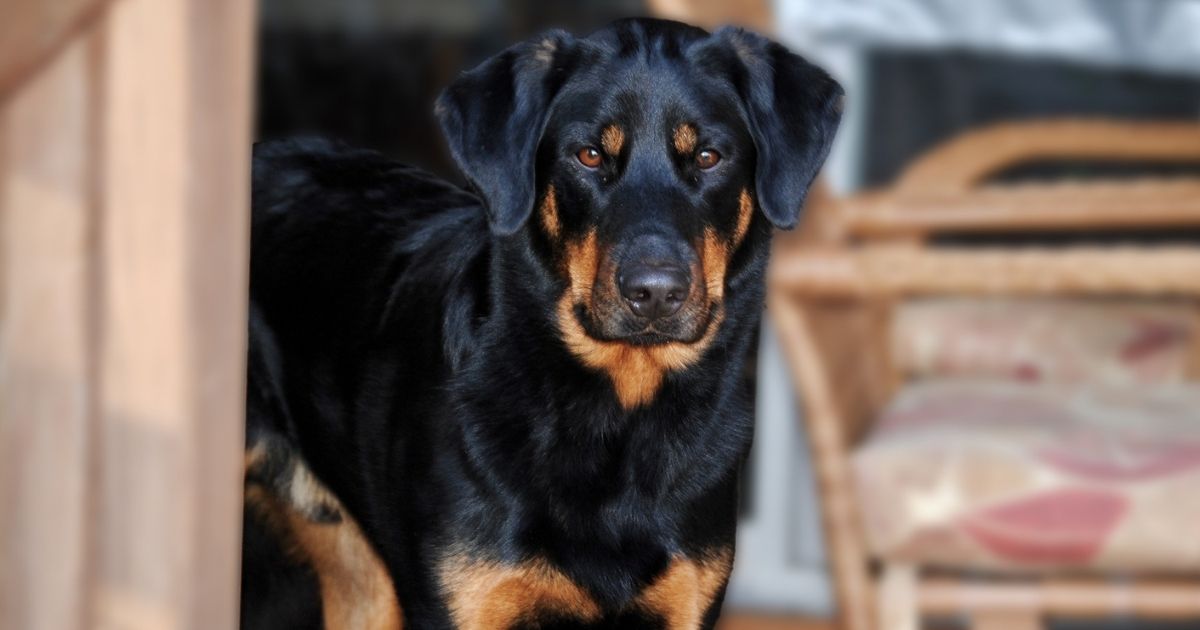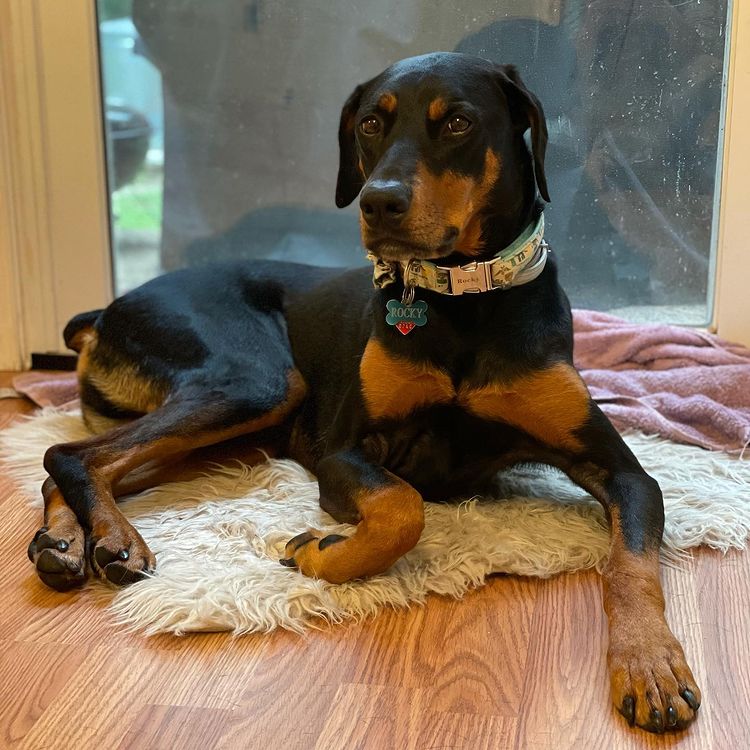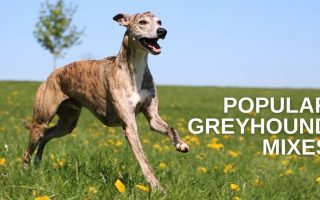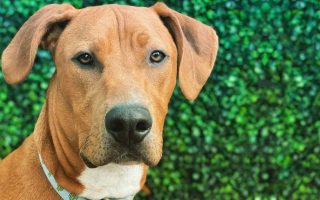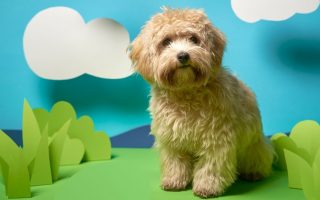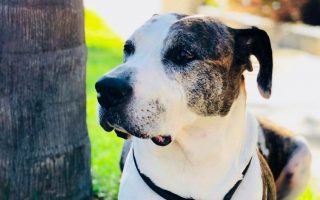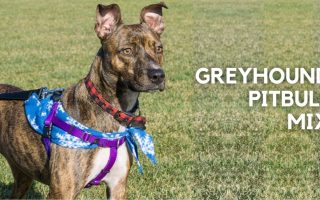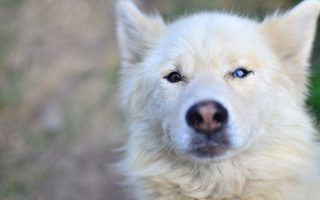The Doberman Rottweiler Mix breed, also known as the Rotterman, is a designer breed that has as parents the Doberman Pinscher and the Rottweiler.
It also goes by other names like the Doberott, Rottie Dobie, Rottie Dobe, and Doberweiler.
The mix originated in the United States, though there isn’t much to know about its history due to its rarity.
It is a large, strong dog breed that needs an owner that’s capable of taking care of a biggie.
They may tend to be aggressive if neglected, so good training and care are important.
An intelligent dog breed with a personality that’s softer than its looks, Rottie Dobe is an interesting pet who plays different roles in a household.
It acts as both a protector and a companion, double blessings for the owner. Anyone who loves big dogs and wants a canine bouncer will want this breed.
This ultimate guide presents facts, tips, and pieces of information you need to know about this breed.
Rotterman Mixed Breed Information
| Height | 23 to 28 inches |
| Weight | 65 to 130 pounds |
| Lifespan | 9 to 12 years |
| Coat | Short |
| Colors | Cream, Tan, Black, Brown |
| Temperament | Loyal, affectionate, dominant, protective, smart |
| Ideal For | Active families with yard, Experienced Owners |
| Puppy Price | $300 – $700 |
Rotterman Puppy Characteristics
| Health | Medium |
| Grooming | Low |
| Friendliness | High |
| Energy | High |
| Trainability | High |
The Parent Breed
Doberman Pinscher
- Lifespan: 10 to 12 years
- Weight: 60 to 100 pounds
- Height: 24 to 28 inches
- Colors: Black & Rust, Blue & Rust, Fawn & Rust, Red & Rust
- Temperament: Alert, Fearless, Loyal
- Recognized by AKC: Yes
It is believed that the Doberman Pinscher owes its existence to several other breeds including the Rottweiler, the German Pinscher, and the Black and Tan Terrier.
It originated in Germany and was developed to be a companion and protector. The brain behind this breed was a tax collector named Louis Dobermann.
To protect himself from roadside bandits, he bred dogs who could guard him while keeping him company.
The Doberman Pinscher was born, survived two near extinctions, and got into the United States in 1908.
Doberman is a highly intelligent, very active, loyal, and faithful breed. It is protective and will defend the family against any danger.
While not unnecessarily aggressive, Intruders will have a hard time with this breed.
It prefers a home with space over an apartment due to its size and energetic nature. The energy also means the breed needs a lot of exercise.
It may give some trouble during training, but overall it can be trained.
Rottweiler
- Lifespan: 9 to 10 years
- Weight: 80 to 135 pounds
- Height: 22 to 27 inches
- Colors: Black & Rust, Black & Tan, Black & Mahogany
- Temperament: Confident, Loyal, Loving
- Recognized by AKC: Yes
Rottie’s older and bigger than the Doberman, and is fondly called a gentle giant by fans.
Although it is feared by the general public, the Rottweiler is more affectionate than people think.
Like Dobie, it was also developed to be a worker. It descended from the Roman Mastiff who came into Germany thanks to their masters.
The eventual mating of the Mastiff and native German dogs led to the Rottweiler.
The breed started off pulling carts and driving cattle. This job continued till it became less necessary. At that point, Rottie faced extinction.
This breed was saved in 1901 when a standard was established. It for recognized by the American Kennel Club in the late 20th century.
They were instrumental in both world wars. It has also worked as a police dog and is now popular (with some notoriety) in the United States.
Important Facts About the Doberman Rottweiler Mix You Should Know
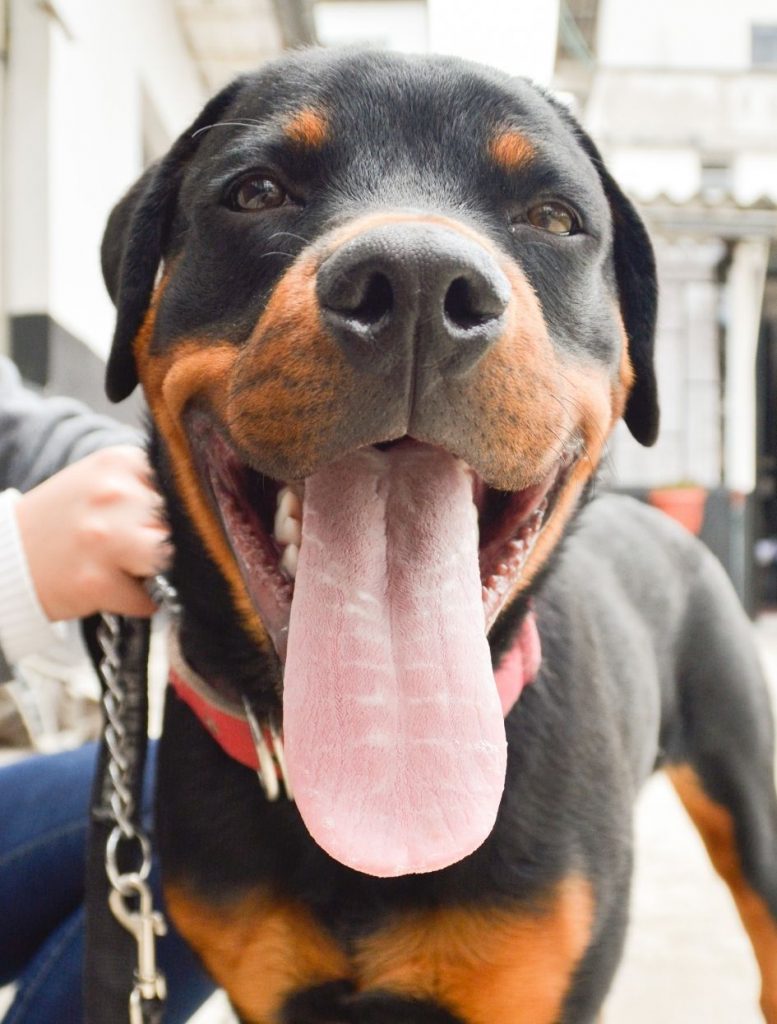
1. It is not a pure breed
The name Rotterman does sound like that of a pure breed. Thus, people tend to think this breed is purebred.
However, you should understand the difference between a pure breed and a designer breed.
While the latter is a hybrid gotten from two pure breeds, the former was bred for generations.
Rotterman is a designer breed. This is why it has many names, different traits, and even differences in looks.
2. It is loyal and loving, but can be stubborn
This breed’s top temperaments are loyalty and love. It is breathing proof that a dog is man’s best friend.
They are ready to die for their masters and prove their affection every day.
Nevertheless, like any typical best friend, this breed can be stubborn. It takes a lot to whip it up to a well-mannered shape.
The breed is not recommended for every family.
3. It loves to work
The designer breed inherited the working spirit of its parents. Thus, it is a workaholic who thrives when there’s something to do.
If you own this dog as a companion, fill in a lot of mental and physical activities to keep it stimulated.
This is why you should be an active person to own this breed.
Exercise is mandatory, so this isn’t the pet for a couch potato or someone who lives a sedentary lifestyle.
4. One parent has multiple personalities
The Doberman Pinscher is known to have different personalities, a quality that makes it harder to ascertain what personality the mix will get.
Some Dobbies are your usual guardians: fearless, courageous, and protective.
Others bend towards being companions and are more sweet than bold.
5. The Rottweiler is named after Rottweil
As the most popular name of the mixed breed is Rotterman, one should know how the name ‘Rottweiler’ originated.
The name was derived from a German town named Rottweil located in a German region now known as Baden-Wurttemberg.
Appearance
General Appearance
This breed can halt you in your tracks with the way it looks.
Unlike some other designer breeds, Rottermans have parents with similar features, making the appearance of each dog almost uniform.
Some people even confuse the parent breeds with the offspring. It has a solid head, more defined but slimmer than that of the Rottweiler.
With a long muzzle and upper lips that droop slightly, the designer breed has a humorous appearance.
Its eyes are worth looking at. They are colored almond or sometimes brown. Other parts of the body will leave no doubt that this breed was developed to be a worker.
It has a well-built chest, lean limbs, all placed in the right proportion. These all contribute to giving this breed a proud stance.
Size
Alongside its parents, this breed is classified as a large dog when it comes to size, and it isn’t hard to see why.
The weight range of the breed falls between 65 to 130 pounds, an impressive figure. It also grows as tall as 23 to 28 inches.
Colors & Coat Type
The Rotterman’s coat is short, straight, and usually shines. When healthy and well taken care of, the coat adds to the overall beauty of this breed.
Often, it combines the coat type of both parents—whose coats aren’t so different.
Black and tan is the most common color you’ll find on dogs of this breed. Besides that, their coat can be brown and cream.
Temperament, Behavior & Intelligence of the Rotterman Mix
As we mentioned earlier, love and loyalty are the top 2 qualities of this breed.
The devotion it has to its family remains unshaken, and it stays faithful to its loved ones. The affection it shows to family members runs deep.
However, this affection doesn’t go towards strangers or new faces. This breed has a natural guardedness against strangers, including visitors.
While this is good because of intruders, you need to socialize your pet to curb any aggressive tendencies.
We also mentioned that this breed has a stubborn nature. It remains loyal, but may not want you bossing it around.
As admirable as that is, it can be a hindrance in training and should be overcome.
Nevertheless, these dogs are softies and gentle. Their ferocity and aggression are often reserved for danger.
They act as both watchdogs and guard dogs, so be certain of some level of safety with these guys around.
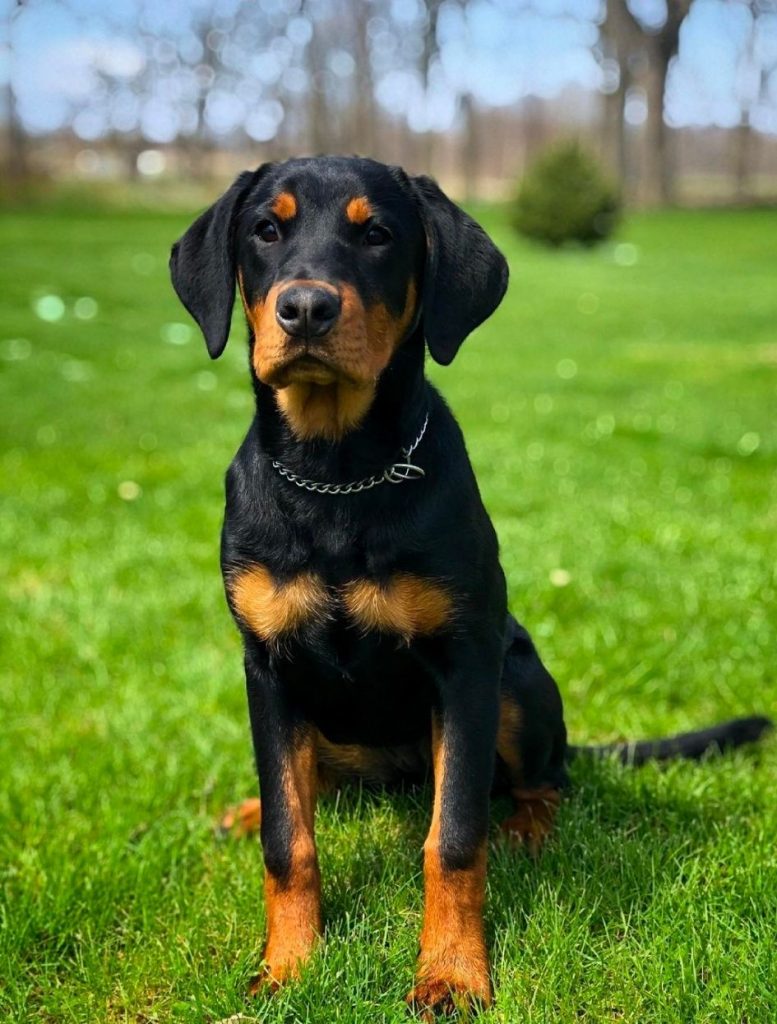
Are They Good Family Dogs?
These dogs are family-friendly when in the right hands. Rottermans are affectionate towards adults and also good with children.
They will watch over your kids and try to keep them away from harm. Unless provoked, these dogs don’t get aggressive towards anyone.
Are They Good With Other Dogs & Pets?
The breed can cope in a house with other dogs when they have been socialized.
Without socialization, don’t expect your adult Rottie Dobbie to say ‘hello’ to a new canine.
You should be more careful with cats and small pets. This breed has a high prey drive.
How Much Does a Doberman Rottweiler Mix Puppy Cost?
Because it is not a pure breed, this hybrid is not too expensive. The price range for a Rotterman puppy falls between $300 to $700.
It may be a bit difficult to find, however, as many breeders would rather breed a purebred Rottie or Dobbie.
Do your homework on the best breeder to get from, and ensure that it is a reputable one.
There are certain things you should know before getting this Mix, especially as it isn’t a pure breed.
Ask for its parents, the medical records, vaccination stats, and even a guarantee.
The AKC outlined a list of questions you should ask a breeder to confirm his/her reputation. They include:
- Have health tests been performed on the parents?
- How do you socialize your puppies?
- How long have you been breeding?
Care to adopt? It does have its perks, mainly the opportunity to spend less.
You need to ask the aforementioned questions to shelters too, as well as background history and any possible records of abuse or trauma.
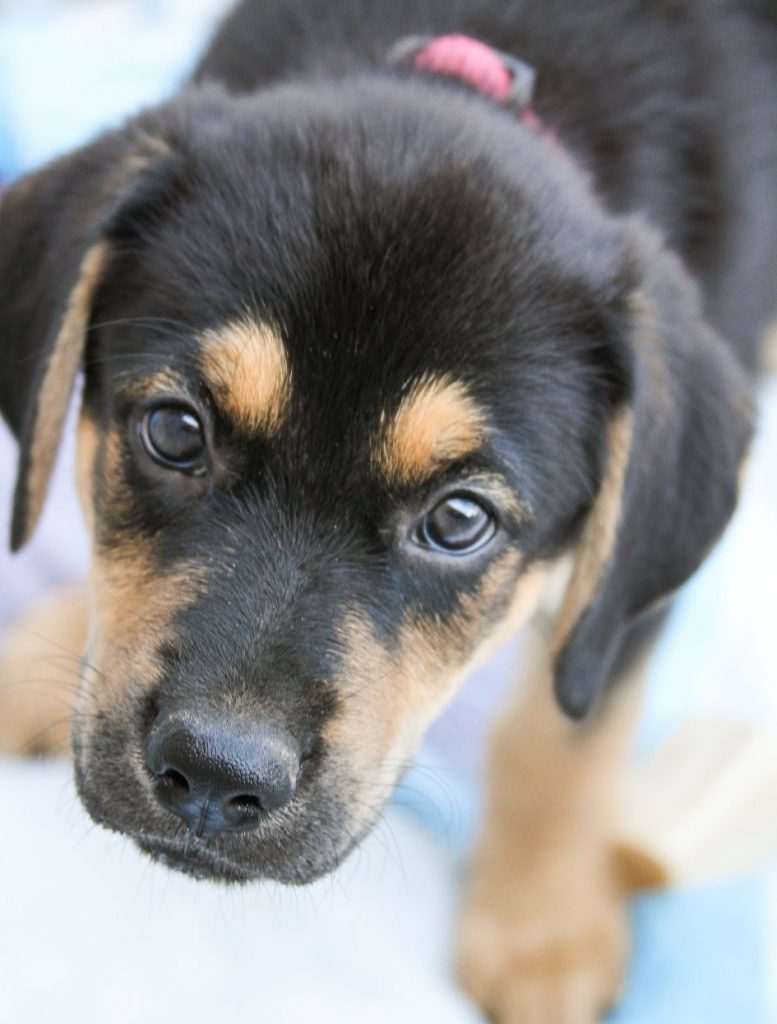
Caring for a Doberman and Rottweiler Mix
Food & Nutrition
The Rottie Dobe has the same appetite as many other large dogs.
As long as it is healthy, you needn’t force this breed to eat as it will gobble up whatever you put in the bowl. While this is good, it calls for caution.
You can’t afford to have an obese, large dog. You need to plan your meal.
The first thing to keep in mind is the nutrients your pooch needs. The top nutrient on the list is protein.
They are energetic and need a lot of protein, especially from animal sources like chicken and beef.
It doesn’t need too much fat, neither should it be fed a high amount of carbohydrates. Those can lead to obesity and other problems.
Omega-3 fatty acids and some vitamins are helpful for your canine’s skin, joints, and overall health. Do not omit these from the feeding plan.
A veterinarian or nutritionist is the best option to advise you on how to feed your pet. Having said that, we recommend 3 cups of high-quality food per day.
Remember to keep current size and age in mind as you establish a routine and the diet. Puppies don’t eat like adults, and this breed is not an exception.
You shouldn’t also feed a lean dog the same way as a normal or obese canine.
Exercise
It is a bad idea to leave this breed without exercise, bad for the dog and your properties.
These active furries have to use up the stored up energy in them, especially when they are household pets with no specific job function.
This is why you must consider your exercise schedule (or lack of it) before making a move to purchase this breed.
A person who isn’t given to long, regular exercise will feel frustrated by the demands of Rottie Dobes
To be satisfied, they need at least 90 minutes of exercise.
That is a lot, but can be made easier if you spread it out throughout the day and combine different activities.
Because of the strength of this breed, it should be given some intensive physical activities.
Hiking is a good example of an activity you can enjoy with your buddy. Brisk walks, jogging, and running are other motion-based exercises.
Some individuals can also swim. If your dog is one, take it swimming so it can move its limbs and have fun.
Besides physical activities, add some mental games to challenge your pet’s intellect.
This breed is highly intelligent and will get bored if you do not stimulate its intellect.
Exercise should be based on age. Find an age-appropriate activity for your pup, increase the intensity during adulthood, then reduce it once more in older years.
What we said about stubbornness applies here. The best way to forestall this trait is by making sure your pet knows you are in charge.
This is why you should begin training when it is still a puppy.
Teach your dog basic commands that it should learn and obey. Fortunately, this breed doesn’t easily forget.
Basic commands include Stop, Sit, Down. You can also teach it some tricks during obedience training.
Socialization involves breaking off any social anxiety this breed is predisposed to.
You achieve this by taking your pet to new places, meeting new people, having it engage with other dogs, introducing it to every member of the family, and letting it develops confidence.
This breed is not the best for novice parents. The chances of frustration are high if you have no idea what you’re doing.
A new pet parent will do better with a Golden Retriever or other less stubborn breed.
Do note that the stubbornness of this breed doesn’t negate its soft side. It doesn’t respond favorably to yelling, harsh words, or hitting.
It is tantamount to abuse and can leave a dog scarred. Be firm, but also be gentle. Rebuke with caution and praise lavishly.
Grooming Needs
It is easy to groom this breed as its short coat doesn’t require much in terms of coat care.
It isn’t a high shedder either, which is a relief for pet parents who hate dealing with doggy hair all over.
Brush the coat a minimum of once per week. This brushing helps remove dead hair or any form of dirt that stuck to the coat while your pet was playing around.
A pin brush is the best for this coat type.
These dogs don’t require (or appreciate) regular baths. Bathing should be kept to a minimum, only when you notice your pet is very dirty.
Be sure the shampoo you use is good for its skin.
Besides those, pay attention to the ears. These ears are shaped in such a manner that they hoard bacteria which can lead to infection.
Clean the ears regularly and watch out for any symptoms of infection.
Other parts of the dog’s body should be taken care of too. Brush the teeth and reduce the nails when too long.
Health & Conditions
This breed has a life span of 9 to 12 years. Compared to other breeds, that isn’t so long.
However, it doesn’t negate the fact that these dogs can be healthy. With proper care, they don’t need constant visits to the vet.
Nevertheless, they are living beings who fall ill like the rest of us. You should know these ailments if only to ensure early detection and quick treatment.
These conditions include:
- Hip Dysplasia: A common doggy illness that’s characterized by a hip abnormality. Symptoms include funny movements and reduced activity.
- Hypothyroidism: Hypothyroidism is caused by a deficiency of the thyroid hormone. Symptoms include fatigue and speedy weight gain.
- Von Willebrand’s: This is an inherited condition that occurs when the protein meant to aid platelets clot is lacking. Symptoms include urinating blood and nosebleed.
- Bloat: Bloating is a dangerous condition that’s caused by the filling of the stomach with foods and other fluids, making the stomach swell.
- Bone Cancer: The most common kind is osteosarcoma which stunts the growth of bone cells. Symptoms include swelling and joint pain.
- Narcolepsy: Narcolepsy affects a dog’s nervous system and makes a dog suddenly fall asleep while in the middle of an activity.
- Wobbler’s Syndrome: This is another disease that affects the neck and is common in large dogs. Symptoms include neck pain, paralysis, lameness, and overall weakness.
How big does a Doberman Rottweiler mix get?
This Mix is a large dog and grows to look imposing to the casual observer. It grows as tall as 23 to 28 inches and weighs up to 130 pounds.
Can you mix Rottweiler with Doberman?
The Rottweiler crossed with the Doberman produces a Mix commonly known as the Rotterman.
It is a good protector, watchdog, and companion.
Why do Dobermans look like Rottweilers?
The Rottweiler is amongst the breeds speculated to have been used by Dobermann while breeding the Doberman Pinscher.
This could explain the resemblance in both breeds.
Who is more aggressive Doberman or Rottweiler?
Both Rottweilers and Dobermans are seen as aggressive by the general populace.
The public opinion is often that the Doberman Pinscher is more aggressive than the Rottweiler, but both breeds are trainable.
Wrap Up
Not everyone can own and maintain this breed, and not everyone should.
The Doberman Rottweiler Mix needs an owner who’s committed to its welfare and has the experience to remove bad habits and inculcate good ones.
In the right hands, this mix has potential.
You May Also Like:
20 Popular Greyhound Mix Dog Breeds (with Pictures)

